Introduction
- Online education: a crucial alternative that improves accessibility (Jones, 2015; Reese, 2015).
- Unique challenges require unique solutions (Jones, 2015); research needed (McPherson & Bacow, 2015).
- Virtual instructors: a solution with multiple benefits.
These days, online education is a very important option. It is a valuable and fairly effective alternative that dramatically increases the accessibility of education (Jones, 2015; Reese, 2015). It also has rather unique challenges and problems that may be less acute in traditional education. Still, there are solutions to such problems, and this presentation will cover one such solution, which is a virtual instructor. A virtual instructor can improve online education experiences, and this presentation will demonstrate this fact.
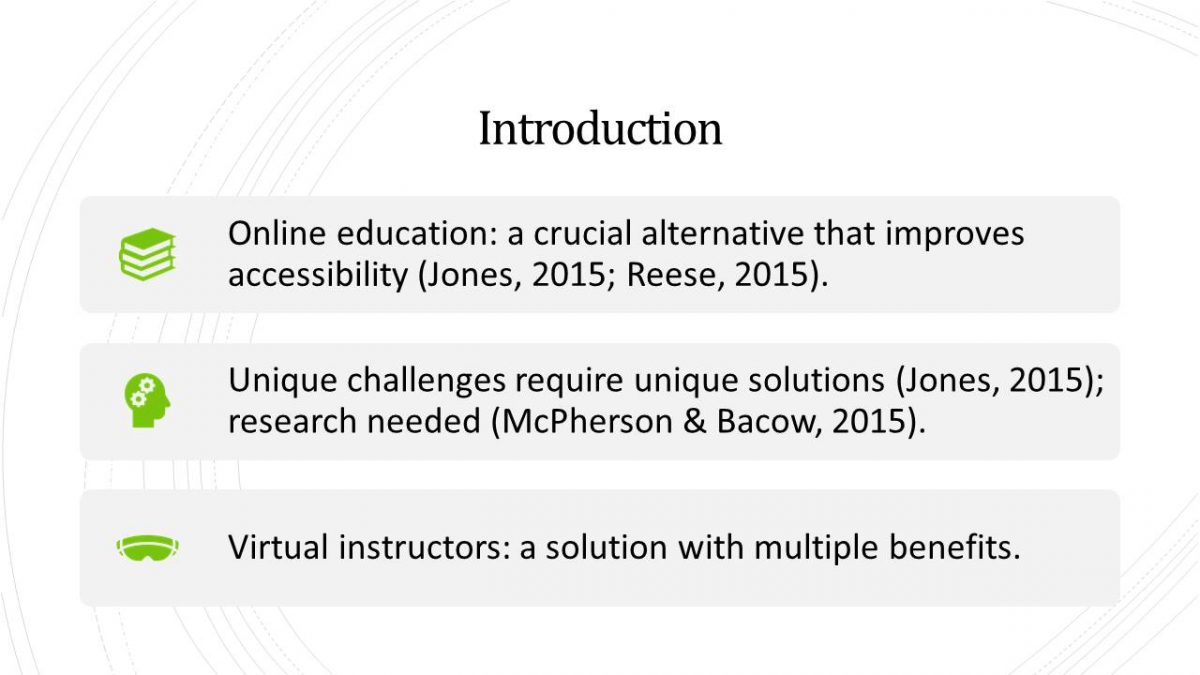
Virtual Instructor: A Definition
- An online course instructor.
- Provides instruction, feedback, and clarifications (Kim & Thayne, 2015).
- Uses video conferencing/calls at least once a week for more immediate interaction.
First, it is necessary to define the terms that we will be using. Online education is self-explanatory; it refers to a form of education that is delivered with the help of communication technologies. The term “virtual instructor” can be defined in different ways, but here, it is the instructor who is actively involved in synchronous and asynchronous communication with the students of an online program. The main function of instructors is to instruct, but they also offer feedback, clarifications, and support. An important aspect of virtual instruction that is considered in this presentation is video conferencing. Weekly technology-assisted video conferences or calls are going to be one of the primary tools of a virtual instructor in resolving a major issue with online education, which is reduced interaction.
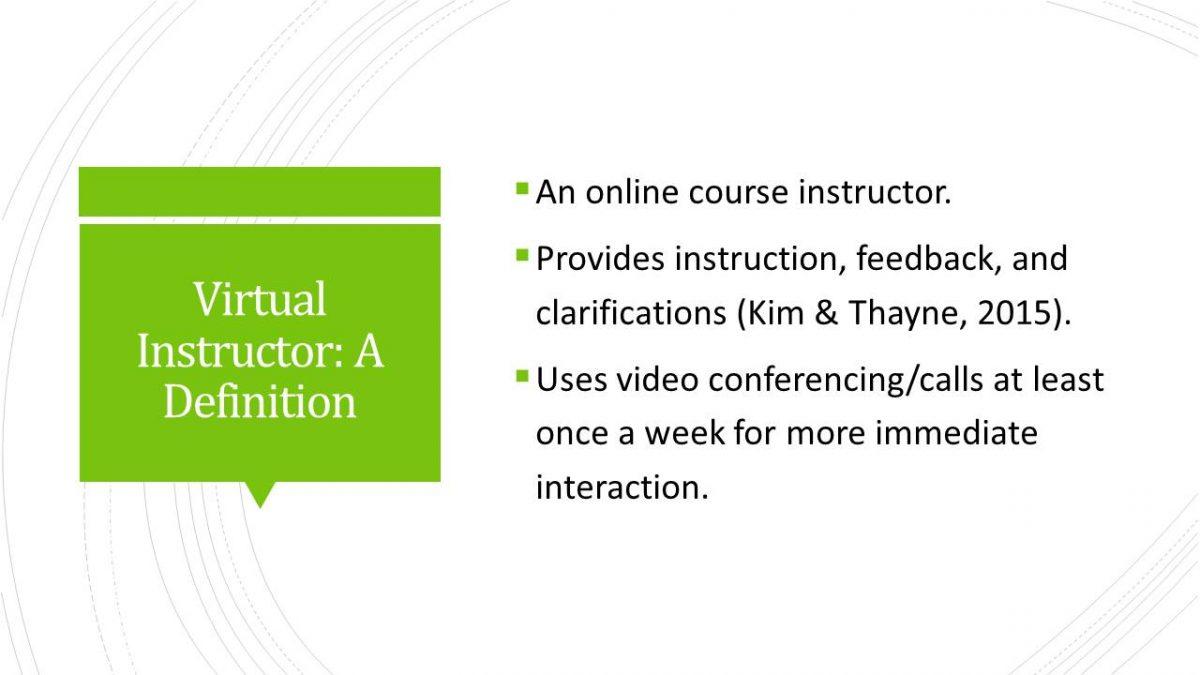
Online Classes: A Problem Statement
- Social learning (SL): learner-learner and learner-instructor interaction (Kyei-Blankson, Ntuli, & Donnelly, 2016).
- SL can have an impact on attitudes and performance (Kim & Thayne, 2015; Reese, 2015).
- Online learning reduces interaction (Huang, 2018; Jones, 2015; Reese, 2015).
There is not much research about virtual instructors, but the sources that do exist discuss the problem of social learning (SL) in online environments. SL is a concept that can be traced back to the works of major education scholars like Vygotsky (Kyei-Blankson et al., 2016). Its basic premise is that as social beings, humans learn better through interaction (Reese, 2015). Research does suggest that interactions and relationships have an impact on learners’ motivations and attitudes toward learning, which, in turn, have been linked to performance (Kim & Thayne, 2015; Reese, 2015). As a result, a major concern for online learning is that online interaction is not fully equivalent to face-to-face interaction, which may result in reduced SL for online learners (Huang, 2018; Jones, 2015; Reese, 2015). For example, a recent study by Huang (2018) showed that the role of instructors in online courses was significantly reduced, especially when affective, emotional roles were considered. From this perspective, online programs can result in reduced support and assistance, which can prevent learner-instructor relationships from forming. In turn, that outcome deprives students of one of the factors that can make them more motivated and interested in learning (Kim & Thayne, 2015; Reese, 2015). Thus, online learning might have a problem with SL.

The Importance of Learner-Instructor Interaction
- Students perceive learner-instructor interaction as important (Kyei-Blankson et al., 2016).
- Learner-instructor relationships lead to positive attitudes, improved engagement, and better performance (Kim & Thayne, 2015).
- Increased instructor presence is correlated with increased satisfaction (Kyei-Blankson et al., 2016).
A note should be made about the significance of specifically learner-instructor interactions and relationships. Students recognize them as an important factor for their education (Kyei-Blankson et al., 2016), and improved relationships between learners and their instructors are evidenced to result in positive outcomes, including performance-related ones (Kim & Thayne, 2015). In addition, a recent study suggests that instructor presence may be correlated with satisfaction in online students (Kyei-Blankson et al., 2016). While correlation might not necessarily imply causation, it is an important finding that supports the promotion of interaction between learners and instructors, especially when the medium of education might be reducing it, which is the case for online learning.
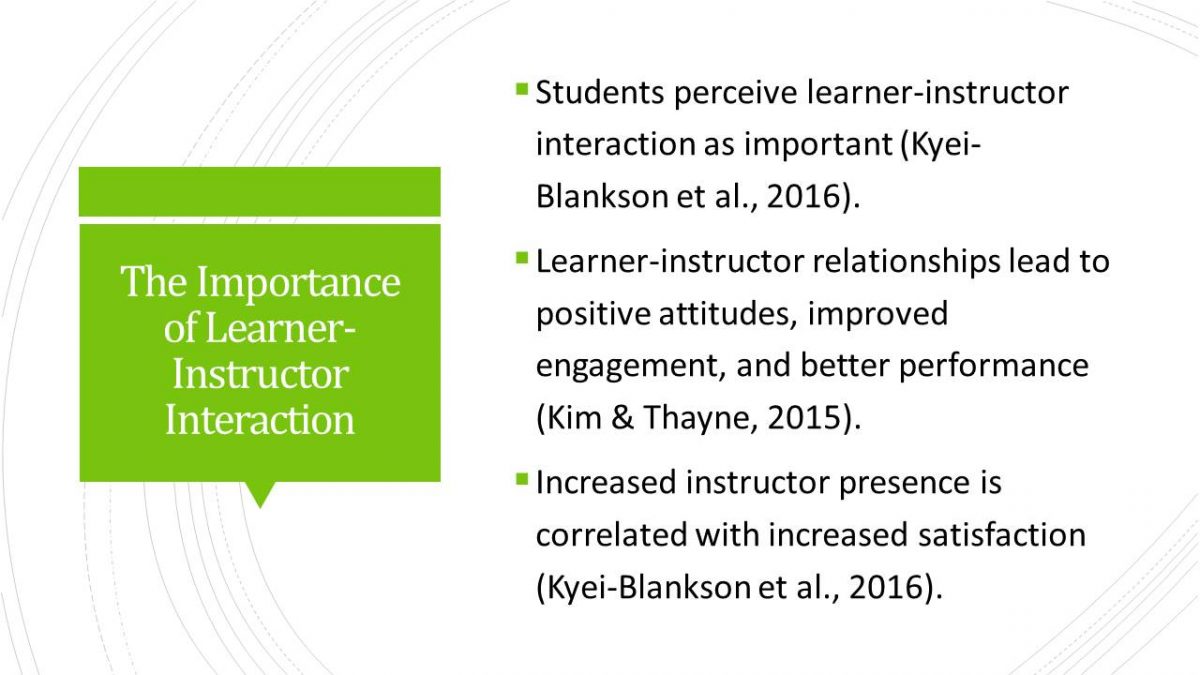
Video: Benefits and Limitations
- Video lectures can improve attitudes and learning (Kim & Thayne, 2015).
- Seeing the face of an instructor improves motivation and perceived SL (Kizilcec, Bailenson, & Gomez, 2015).
- When asynchronous, it might not support learner-instructor relationships (Kim & Thayne, 2015).
Admittedly, a virtual instructor is not the only way of addressing the SL problem. The most common solution is video lectures, which is an asynchronous approach. Even voice-over video lectures are shown to be beneficial for students, resulting in good attitudes toward their learning and improved motivation (Kim & Thayne, 2015). In addition, a recent experiment by Kizilcec et al. (2015) shows that adding the face of an instructor to a video lecture can improve students’ motivation and the perceived instructor presence, which is beneficial for SL. From this perspective, the value of seeing the virtual instructor is apparent. However, a recent study by Kim and Thayne (2015) found that the relationship between learners and instructors in voice-over lectures might not improve over time. While many factors may have caused this issue, including, for instance, the personal qualities of the instructor, it makes sense to consider the alternative, which is synchronous interaction.
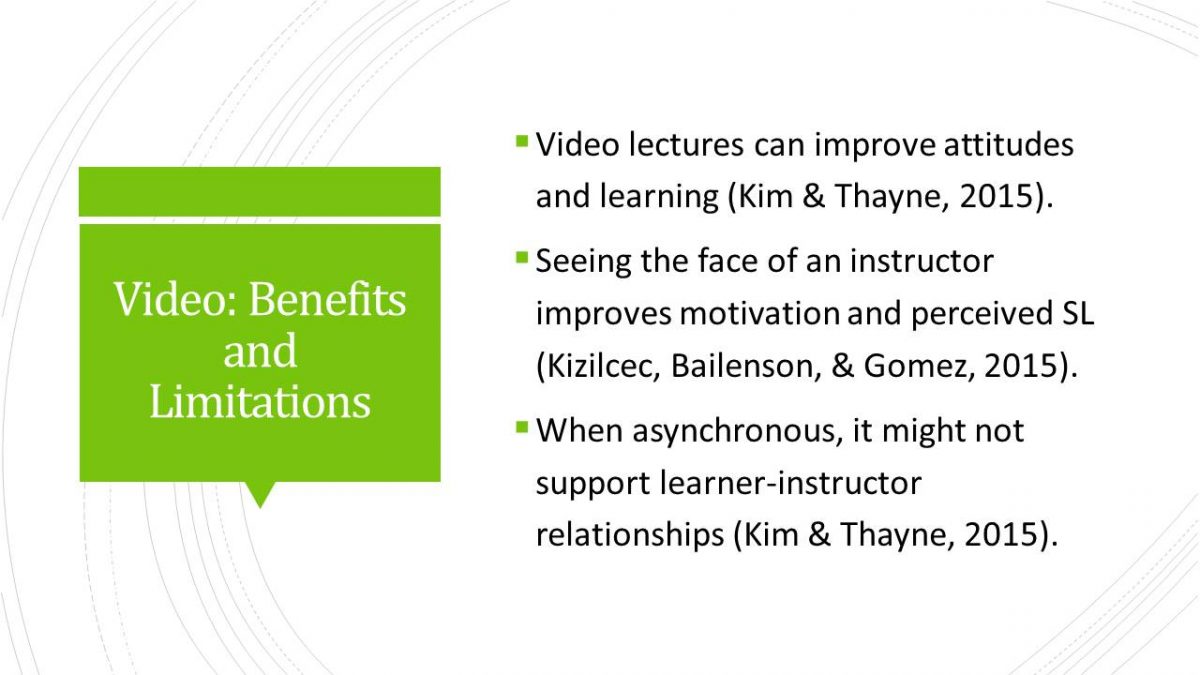
Synchronous Interaction
- Benefits:
- instant answers;
- facilitates problem-solving;
- more opportunities for relationship-building.
- Limitations:
- time/resources;
- students’ preferences (Nandi, Hamilton, & Harland, 2015).
The value of synchronous interaction is recognized by many students. Among other things, they report the possibility of getting answers immediately, which may facilitate learning and problem-solving (Nandi et al., 2015). If the value of synchronous interaction is combined with the benefits of seeing the instructor, video calls become a very important tool for improving learner-instructor interaction (Kizilcec et al., 2015). Admittedly, some students might prefer asynchronous interaction and may want to avoid seeing their instructor (Kizilcec et al., 2015; Nandi et al., 2015). However, one of the benefits of a virtual instructor is that he or she can combine different methods of interactions based on students’ preferences. The important part is to ensure that there is a virtual instructor who can dedicate enough time to the task of enabling SL in online students with the help of video calls and other approaches.
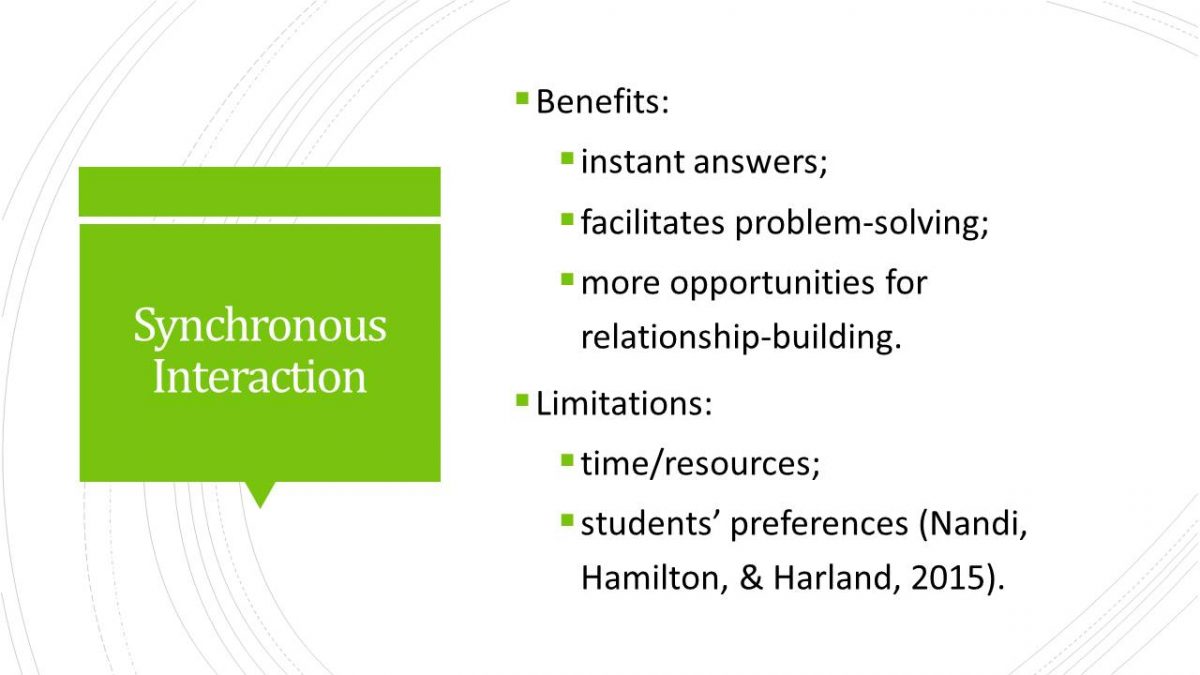
The Benefits and Value of Virtual Instructor
- Helps to resolve the SL problem.
- Helps to build instructor-learner relationships.
- May improve motivation, attitudes, performance, and satisfaction.
- May use the benefits of video conferencing or other options.
Thus, the presented information allows making the following conclusions. The employment of a virtual instructor allows resolving one of the greatest problems of online education by promoting social interaction in online courses. The application of video conferencing and other options allows employing multiple opportunities for building instructor-learner relationships, which, in turn, are evidenced to result in better motivation, attitudes, and performance. Given that improved instructor presence can also result in greater satisfaction, a virtual instructor is an asset for both learners and educational institutions.
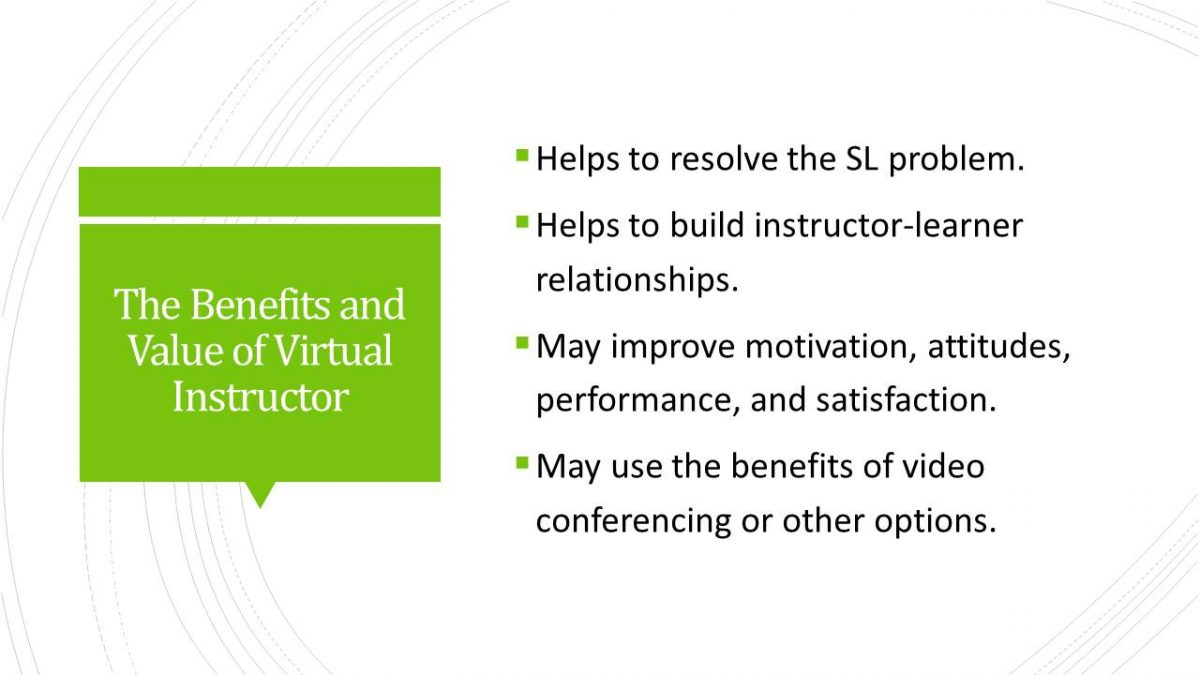
Conclusion
- Problem: improving/increasing interaction.
- Solution (supported by evidence): virtual instructor.
- Additional benefits: motivation, positive attitudes, satisfaction.
In summary, despite the limited amount of literature that would actually discuss virtual instructors, they appear to be a solution to the lack of interaction in online courses, which is supported by evidence. Furthermore, the likelihood of other benefits, including student satisfaction and motivation, is also evidence-based. Therefore, the inclusion of virtual instructors in online courses is a reasonable decision.
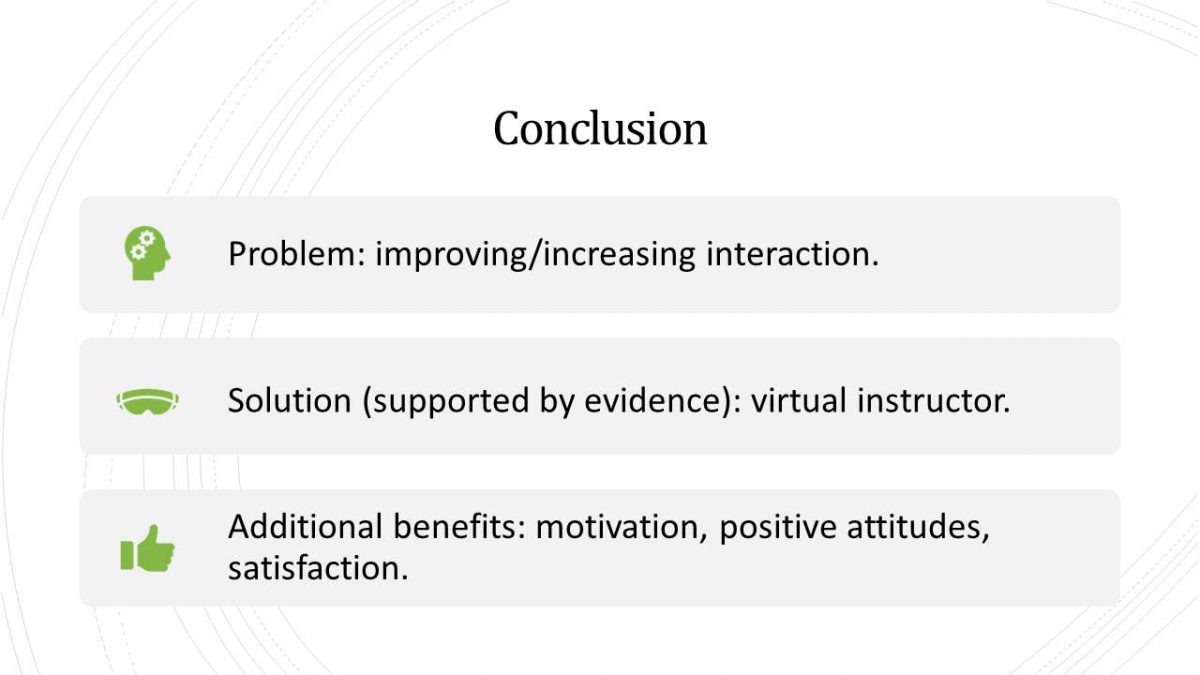
References
Huang, Q. (2018). Examining teachers’ roles in online learning. The Eurocall Review, 26(2), 3-18. doi: 10.4995/eurocall.2018.9139
Jones, S. (2015). Benefits and challenges of online education for clinical social work: Three examples. Clinical Social Work Journal, 43(2), 225-235. doi: 10.1007/s10615-014-0508-z
Kim, Y., & Thayne, J. (2015). Effects of learner–instructor relationship-building strategies in online video instruction. Distance Education, 36(1), 100-114. doi: 10.1080/01587919.2015.1019965
Kizilcec, R., Bailenson, J., & Gomez, C. (2015). The instructor’s face in video instruction: Evidence from two large-scale field studies. Journal of Educational Psychology, 107(3), 724-739. doi: 10.1037/edu0000013
Kyei-Blankson, L., Ntuli, E., & Donnelly, H. (2016). Establishing the importance of interaction and presence to student learning in online environments. World Journal of Educational Research, 3(1), 48-65. doi: 10.22158/wjer.v3n1p48
McPherson, M., & Bacow, L. (2015). Online higher education: Beyond the hype cycle. Journal of Economic Perspectives, 29(4), 135-154. doi: 10.1257/jep.29.4.135
Nandi, D., Hamilton, M., & Harland, J. (2015). What Factors impact student – content interaction in fully online courses. International Journal OF Modern Education and Computer Science, 7(7), 28-35. doi: 10.5815/ijmecs.2015.07.04
Reese, S. (2015). Online learning environments in higher education: Connectivism vs. dissociation. Education and Information Technologies, 20(3), 579-588. doi: 10.1007/s10639-013-9303-7